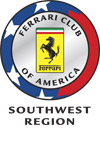
Tech Tip - Track Preparation
By: Gary Bobileff
Many of you have wondered how fun it would be to run your car in a club event with other Ferraris. I say that if you have the talent, do it!
But first, you must insure that your car is fit for the track. It goes without saying that the demands that one will put on the car will be far greater than normal street driving. Therefore, the preparation needed to run the car on the track becomes vital.
Just prior to running the car the following items should be done to ensure your safety, as well as the safety of others around you. The brake system should be flushed with a high quality brake fluid such as Castrol LMA or equivalent. The fluid selected should have a published rating exceeding DOT 3 and 4 specifications. Anything less should not be used. Be very careful of synthetics. Only a few are truly compatible with the rubber seals that Ferrari uses. Some silicone synthetics have been known to swell the seals in the braking system so severely that once the brakes are applied they don?t retract and the car will not move. I have successfully used "Motul" fluid from France, which can be found at better racer supply stores. The most important point is use fresh, high quality fluid in order to remove contaminants and moisture.
Observe all suspension and braking pieces very carefully, while the wheels are removed from the car. Any leaky item should be repaired at once, as well as taking no risks with any known suspension item. If you are unfamiliar with brake flushing and the proper way to check all suspension components, it is strongly advised to have a professional who is familiar with your car perform the above.
Oil leaks should be observed, and corrected at this time. If your motor is not completely clean (not just the top) have it degreased and washed. Give a thorough road test, recheck for any leaks and have them corrected at once. Once you are putting your machine through the paces on the track, the oil will slosh in the pan and high oil temperature can cause the oil to thin, thus causing it to seep and leak much easier than during normal street driving. This can contaminate the track and be disastrous, or at least make you unpopular with the rest of the drivers.
A high quality fire extinguisher should be mounted within easy reach of the driver. Do not accept a plastic mount. Only steel or stainless will do. If you choose Halon, try to find a "mix" of 1211 and 1301. This mix has proven to be 7 times more effective than straight Halon. The problem is that it is now illegal because of poking holes in the ozone layer. So, the choice is yours, let the car burn and save the planet, or... you know the rest!
Check all seat belt attachment points, making sure that each point is tight and secure. In the case of using stock belts, check for any frayed portions of the belt and replace the belts at once. Also, be sure to check the seat anchorage points, making sure the hardware is tight.
Remove any shifting items from the interior, including carpeting and mats. These items have been known to bunch up in the pedal assemblies with unhappy results.
Coolant systems should be in top shape, as the high temperatures of the motor being put through the paces magnifies any deficiencies.
Wheels should be retorqued to their proper specifications and knock offs rechecked for tightness. Observe any road hazard damage and tire condition at this time.
If all the above checks are done, when you bring your car in for technical inspection you should pass with flying colors (rosso corsa, of course).
About the author: Gary Bobileff of Bobileff Motorcar Co. has been doing the Ferrari fix in San Diego since 1979. If you have any questions please call (619) 622-1600. He is particularly interested in topics you?d like to have addressed in future tech tips.
